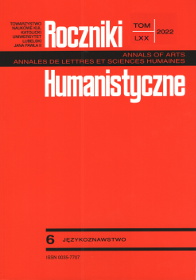Potrzeby społeczne a potencjał językowy. O możliwościach realizacji ekwiwalencji żeńskich nazw osobowych i nazw zawodów w języku polskim i niemieckim – stan aktualny
Abstrakt
Uwarunkowane społecznie potrzeby realizacji pewnych form wyrazu często są odmienne w różnych kręgach kulturowych. Nawet najbardziej zdeterminowane społecznie użycie języka jest jednak możliwe wyłącznie w ramach aktualnie dostępnych środków językowych. Artykuł przedstawia wyniki najnowszych badań nad sformułowanym w tytule problemem przeprowadzonych wśród kobiet w Polsce oraz w Niemczech. Celem pracy jest stwierdzenia ewentualnych zmian, zachodzących od czasu przeprowadzonej dziesięć lat temu analizy realizacji żeńskich nazw osobowych w języku polskim oraz niemieckim. Badanie wyróżnia się spośród innych analiz tym, że obserwacji poddano nazwy sformułowane przez użytkowniczki języka w odniesieniu do samych siebie. Praca potwierdza istniejącą nadal asymetrię w tworzeniu i używaniu żeńskich nazw osobowych w obydwu językach. Asymetria ta nie jest jednak wyłącznie wyrazem postaw i nie może stanowić jedynego kryterium oceny mentalności danej grupy kulturowej. Jest ona także uwarunkowana aktualnymi możliwościami systemu językowego.
Bibliografia
Bartnicka, Barbara, et al. Grammatik des Polnischen. Otto Sagner, 2004.
Bąk, Paweł. „Berufliche Frauenbezeichnungen oder weibliche Berufsbezeichnungen? Möglichkeiten und Grenzen der Erfassung von Äquivalenzen im Bereich der Politischen Korrektheit am Beispiel des Polnischen und Deutschen”. Text und Stil, hrsg. von Zofia Bilut-Homplewicz et al., Peter Lang, 2010, S. 355-369.
Bąk, Paweł. „Poprawność polityczna a problem ekwiwalencji polskich i niemieckich żeńskich nazw osobowych”. Lingwistyka Stosowana. Applied Linguistics. Angewandte Linguistik, Bd. 8, 2013, S. 27-41.
Błaszkowska, Hanka. Weibliche Personenbezeichnungen im Deutschen und Polnischen aus der Sicht der feministischen Sprachkritik. Wydział Neofilologii UAM w Poznaniu, 2016.
Cieszkowski, Marek. „Zum geschlechtergerechten Sprachgebrauch am Beispiel deutscher und polnischer Stellenausschreibungen”. Linguistik online, Nr. 70, 1/15, 2015, S. 23-42.
Coseriu, Eugenio. „Portée et limites de la traduction”. Parallèles. Cahiers de l’École de Traduction et d’Interprétation de l’université de Genève, Nr. 19, 1997, S. 19-34.
Dargiewicz, Anna. „Ist das Polnische eine geschlechtergerechte Sprache? Zur Movierung im Polnischen”. Prace Językoznawcze, Nr. 23/1, 2021, S. 179-198.
Habrajska, Grażyna. „Poprawność polityczna”. Rozmowy o komunikacji. 1. Poprawność polityczna, hrsg. von Grażyna Habrajska, Leksem, 2006, S. 17-27.
Hughes, Geoffrey. Political correctness: oder die Kunst, sich selbst das Denken zu verbieten. Übersetzung von Sabine Roth u. Regina Rawlinson, Knaur, 2010.
Kothoff, Helga. „Gender-Sternchen, Binnen-I oder generisches Maskulinum, … (Akademische) Textstile der Personenreferenz als Registrierungen?” Linguistik online, Nr. 103, 3/20, 2020, S. 105-127.
Łaziński, Marek. O panach i paniach. Polskie rzeczowniki tytularne i ich asymetria rodzajowo-płciowa. Wydawnictwo Naukowe PWN, 2006.
Łaziński, Marek, u. Waldemar Czachur. „Geschlechtergerechte Sprache im Polnischen“. Muttersprache, Nr. 1/130, 2020, S. 88-91.
Singleton, David, u. Jeffrey L. Kallen. „Lexicon”. Sociolinguistics. An International Handbook of the Science of Language and Society. Volume 1, hrsg. von Ulrich Ammon et. al., de Gruyter, 2004, S. 530-539.
Wilson, Deirdre, u. Dan Sperber. Meaning and Relevance. Cambridge University Press, 2012.
Zifonun, Gisela, u. Ewa Drewnowska-Vargáné. „Die sprachliche Sichtbarkeit der Geschlechter. Genus und Sexus im Deutschen und Polnischen”. vnd der gieng treulich, weislich vnd mëndlich mit den sachen vmb“: Festschrift für Péter Bassola zum 75. Geburtstag, hrsg. von Ewa Drewnowska-Vargáné et al., Institut für Germanistik der Universität Szeged, 2019, S. 138-170.
Copyright (c) 2022 Roczniki Humanistyczne

Utwór dostępny jest na licencji Creative Commons Uznanie autorstwa – Użycie niekomercyjne – Bez utworów zależnych 4.0 Międzynarodowe.





